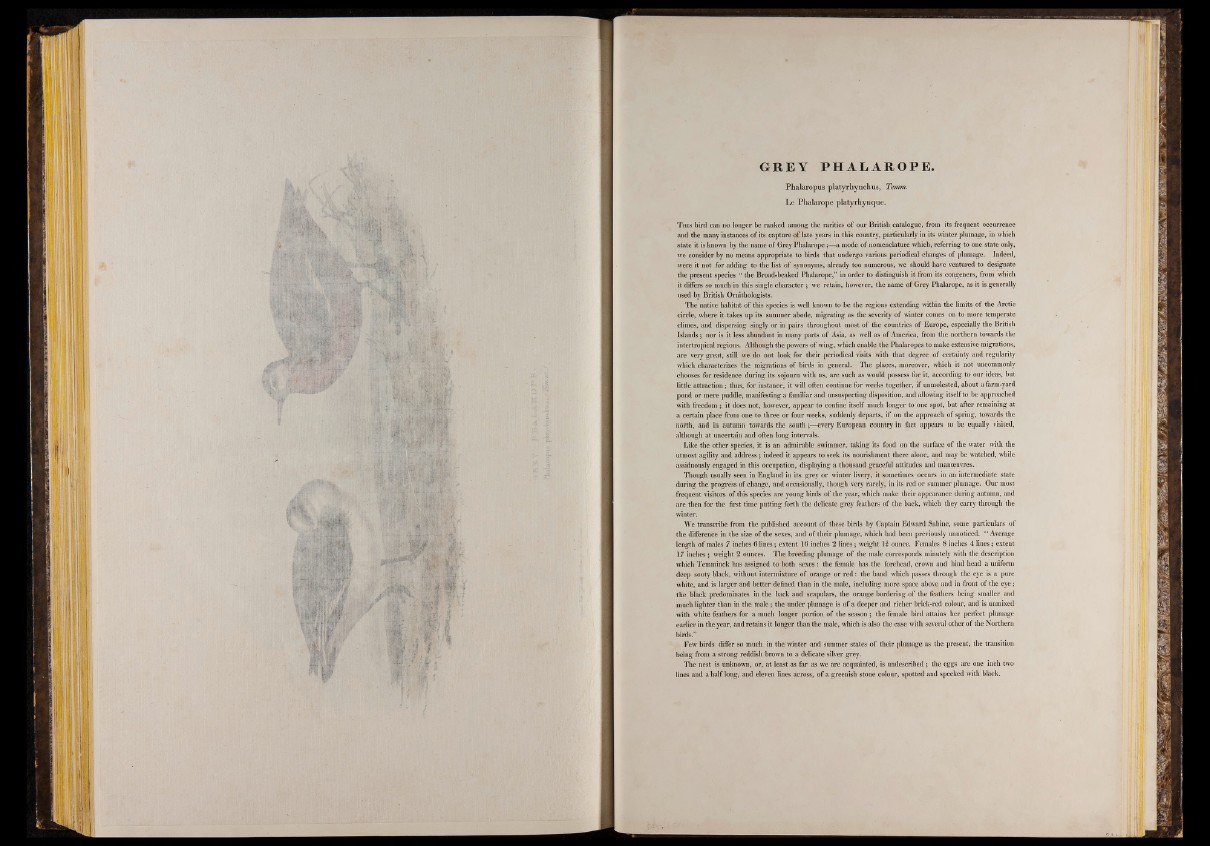
G R E Y PHALAROPE.
Phalaropus platyrhynchus, Temm.
Le Phalarope platyrhynque.
T h is bird can no longer be ranked among the rarities o f our British catalogue, from its frequent occurrence
and the many instances o f its capture o f late years in this country, particularly in its winter plumage, in which
state it is known by the name o f Grey Phalarope ;— a mode o f nomenclature which, referring to one state only,
we consider by no means appropriate to birds that undergo various periodical changes o f plumage. Indeed,
were it not for adding to the list o f synonyms, already too numerous, we should have ventured to designate
the present species “ the Broad-beaked Phalarope,” in order to distinguish it from its congeners, from which
it differs so much in this single character ; we retain, however, the name o f Grey Phalarope, as it is generally
used by British Ornithologists.
The native habitat o f this species is well known to be the regions extending within the limits o f the Arctic
circle, where it takes up its summer abode, migrating as the severity o f winter comes on to more temperate
climes, and dispersing singly or in pairs throughout most o f the countries o f Europe, especially the British
Islands ; nor is it less abundant in many parts o f Asia, as well as o f America, from 'the northern towards the
intertropical regions. Although the powers o f wing, which enable the Phalaropes to make extensive migrations,
are very great, still we do not look for their periodical visits with that degree o f certainty and regularity
which characterizes the migrations of birds in general. The places, moreover, which it not uncommonly
chooses for residence during its sojourn with us, are such as would possess for it, according to our ideas, but
little attraction ; thus, for instance, it will often continue for weeks together, i f unmolested, about a farm-yard
pond or mere puddle, manifesting a familiar and unsuspecting disposition, and allowing itself to be approached
with freedom ; it does not, however, appear to confine itself much longer to one spot, but after remaining at
a certain place from one to three or four weeks, suddenly departs, i f on the approach o f spring, towards the
north, and in autumn towards the south ;— every European country in fact appears to be equally visited,
although at uncertain and often long intervals.
Like the other species, it is an admirable swimmer, taking its food on the surface o f the water with the
utmost agility and address ; indeed it appears to seek its nourishment there alone, and may be watched, while
assiduously engaged in this occupation, displaying a thousand graceful attitudes and manoeuvres.
Though usually seen in England in its grey or winter livery, it sometimes occurs in an intermediate state
during the progress o f change, and occasionally, though very rarely, in its red or summer plumage. Our most
frequent visitors o f this species are young birds o f the year, which make their appearance during autumn, and
are then for the first time putting forth the delicate grey feathers o f the back, which they carry through the
winter.
We transcribe from the published account o f these birds by Captain Edward Sabine, some particulars of
the difference in the size of the sexes, and o f their plumage, which had been previously unnoticed. “ Average
length o f males 7 inches 6 lines ; extent 16 inches 2 lines ; weight I I ounce. Females 8 inches 4 lines ; extent
17 inches ; weight 2 ounces. The breeding plumage o f the male corresponds minutely with the description
which Temminck has assigned to both sexes : the female has the forehead, crown and hind head a uniform
deep sooty black, without intermixture o f orange or red : the band which passes through the eye is a pure
white, and is larger and better defined than in the male, including more space above and in front o f the eye ;
the black predominates in the back and scapulars, the orange bordering o f the feathers being smaller and
much lighter than in the male ; the under plumage is o f a deeper and richer brick-red colour, and is unmixed
with white feathers for a much longèr portion o f the season ; the female bird attains her perfect plumage
earlier in the year, and retains it longer than the male, which is also the case with several other o f the Northern
birds.
Few birds differ so much in the winter and summer states o f their plumage as the present, the transition
being from a strong reddish brown to a delicate silver grey.
The nest is unknown, or, at least as far as we are acquainted, is undescribed ; the eggs are one inch two
lines and a half long, and eleven lines across, o f a greenish stone colour, spotted and specked with black.